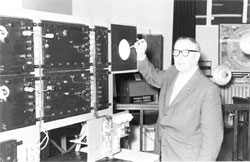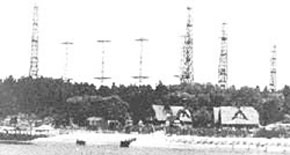April, 1935: British Patent for Radar System for Air Defense Granted to Robert Watson-Watt
 |
| Sir Robert Watson-Watt |
Many scientists and engineers contributed to the development of radar systems, which played a vital role in the Allied victory in WWII. Radar (the acronym stands for Radio Detection And Ranging), detects distant objects such as airplanes or ships by sending pulses of radio waves and measuring the reflected signal. One of the greatest radar pioneers was Sir Robert Watson-Watt, who developed the first practical radar system that helped defend the British in WWII.
The basic principles needed for radar systems were established in the 1880s, when German physicist Heinrich Hertz first produced and transmitted radio waves across his laboratory. He discovered that the invisible waves were a form of electromagnetic radiation, and noticed that some materials transmit radio waves while others reflect them.
Radio waves were quickly put to use. In 1901, Italian physicist Guglielmo Marconi sent the first wireless radio communication across the Atlantic Ocean. In 1904 German engineer Christian Huelsmeyer invented a crude system that used radio waves to prevent boats and trains from colliding on foggy days. US navy researchers also discovered that they could detect ships using radio wave echoes, but their invention was largely ignored.
Some work on early radar detection systems continued during the 1920’s and 1930’s in the United States and elsewhere. But the value of the technology was most obvious in Great Britain, which was especially vulnerable to German air attack.
Sir Robert Watson-Watt, a descendant of steam engine pioneer James Watt, was born in Brechin, Scotland in April 1892. He graduated from University College, Dundee, in 1912 and then worked as an assistant for Professor William Peddie, who encouraged his fascination with radio waves.
In 1915, Watson-Watt hoped to go to work for the War Office, but no suitable position in communications was available there, so he joined the Meteorological Office. He was put to work developing systems for detecting thunderstorms. Lightning ionizes the air and generates a radio signal, which Watson-Watt could detect to map the positions of thunderstorms.
Possibly prompted by rumors that the Germans had produced a “death ray,” in 1934 the Air Ministry asked Watson-Watt to investigate such a possibility. The Air Ministry had already offered 1000 pounds to anyone who could demonstrate a ray that could kill a sheep 100 yards away. Watson-Watt concluded that such a device was highly unlikely, but wrote a memo saying that he had turned his attention to “the difficult, but less unpromising, problem of radio-detection as opposed to radio-destruction.” Watson-Watt and his assistant made some calculations and applied some of the same techniques he used in his atmospheric work.
In February 1935 Watson-Watt demonstrated to an Air Ministry committee the first practical radio system for detecting aircraft. The Air Ministry was impressed, and in April Watson-Watt received a patent for the system and funding for further development. Soon Watson-Watt was using pulsed radio waves to detect airplanes up to 80 miles away.
Shortly before World War II began, the British constructed a network of radar stations along the coast of England using Watson-Watts’ design. These stations, known as Chain Home, successfully alerted the Royal Air Force to approaching enemy bombers, and helped defend Britain against the German Luftwaffe in the Battle of Britain.
 |
| Chain home radar station |
The Chain Home system worked fairly well, but it required huge antennas, and used long wavelengths that limited ability to pinpoint enemy aircraft accurately. During the day, fighter pilots could see enemy bombers. But soon the Germans began nighttime bombing missions, so to help fighter pilots locate enemy aircraft at night, the British needed a shorter wavelength radar system that was compact enough to install in planes.
This became possible when British engineers Harry Boot and John Randall invented the cavity magnetron in early 1940. The magnetron generated about 400 hundred watts of power at wavelengths about 10 centimeters, enough to produce echoes from airplanes many miles away.
Britain didn’t have the large-scale manufacturing capability to mass-produce the magnetron, so in 1940 a mission led by Henry Tizard secretly brought the magnetron to the United States and persuaded the US to help develop and produce the device. The MIT Radiation Laboratory, was set up and quickly became one of the largest wartime projects, employing about 4000 people. Researchers and workers there made mass-production versions of the magnetron and developed about 100 different radar systems.
Germany and Japan also invented their own radar systems, but those were in general less effective, and the Allies’ radar superiority is sometimes credited with the victory in WWII.
After the war, many peaceful uses for radar technology were found. Today air traffic control depends on radar to keep commercial aircraft from colliding. Radar is essential for tracking the weather. The cavity magnetron is now used to cook food in microwave ovens. And many motorists have been caught speeding by police radar guns, including, reportedly, Sir Watson-Watt himself.
©1995 - 2024, AMERICAN PHYSICAL SOCIETY
APS encourages the redistribution of the materials included in this newspaper provided that attribution to the source is noted and the materials are not truncated or changed.
Associate Editor: Jennifer Ouellette
Staff Writer: Ernie Tretkoff
April 2006 (Volume 15, Number 4)
Articles in this Issue

